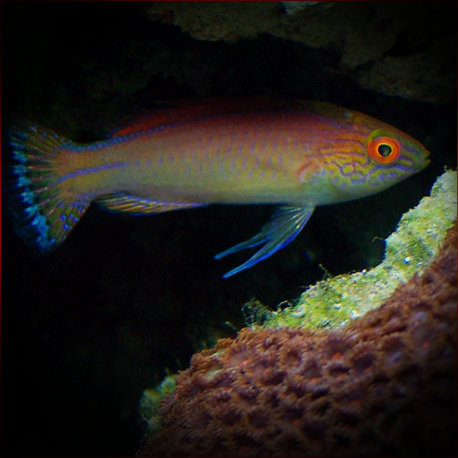More info
Datasheet
| Minimum Tank Size | 400 litres / 105.67 US gallons |
| Maximum Size | 9.0cm / 3.54inches |
| Reef Compatible | Always reef safe |
| Temperament | Docile |
| Temperature | 22.2°C / 71.96°F - 25.6°C / 78.08°F |
| Specific Gravity | 1.020-1.025 |
| Carbonate Hardness | 8-12 |
| pH | 8.1-8.4 |
General Description
Pyle's wrasse, scientifically known as Cirrhilabrus pylei, belongs to the Labridae family and is commonly referred to as the Blue-margin fairy-wrasse. These fish are characterized by their vibrant colors, with males often displaying a striking appearance compared to females. They are suitable for aquarium life, adding a pop of color and activity to a well-maintained tank.
Aquarium Suitability (or if Suitable?)
Pyle's wrasse is considered suitable for aquariums, but with care. They are generally peaceful but can be territorial, especially towards similar species. It is recommended to introduce the largest males last and provide ample space for them to thrive. A tank size of at least 400 liters is advised, with a secure lid to prevent them from jumping out.
Demands, Care, and Hardiness
This species has average hardiness and is known to be sensitive during transportation and acclimatization. They require a varied diet consisting of small crustaceans and zooplankton, feeding multiple times a day. Pyle's wrasse also need hiding spots within live rocks, especially when feeling threatened or resting.
Reef Suitability
Pyle's wrasse is reef safe and can be a beneficial addition to a reef tank. They help control populations of unwanted invertebrates like flatworms and pyramide snails. However, their compatibility with other tank mates should be monitored closely, especially with more aggressive species.
Aquarium Setup
Setting up an aquarium for Pyle's wrasse involves providing ample swimming space and incorporating live rocks for hiding places. Maintaining water conditions within the parameters of pH 8.1-8.4, specific gravity of 1.020-1.025, temperature between 22.2-25.6°C, and a carbonate hardness of 8-12 dKH is crucial for their well-being.
Behaviour
These wrasses can exhibit territorial behavior, especially among males. It is advisable to keep one male with several females or a mated pair for a harmonious tank environment. They may also change gender from male to female, a natural phenomenon observed in some species.
Feeding and Diet
Feeding Pyle's wrasse a varied diet consisting of frozen and flake foods is essential to maintain their health and vibrant colors. They have a high activity level and should be fed at least twice daily to ensure they receive adequate nutrition for their energy requirements.
Dimorphism
There is a noticeable dimorphism between male and female Pyle's wrasse, with males typically displaying more vibrant colors. Males may lose their coloration if not kept with a group of females. Additionally, these wrasses can change gender between male and female.
Habitat and Distribution
Pyle's wrasse are native to the Western Pacific region, specifically found in Papua New Guinea and Indonesia. They inhabit coral reefs and rocky areas, where they seek shelter and forage for food among the live rock crevices.

